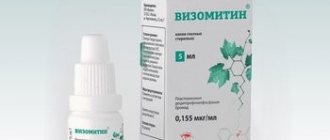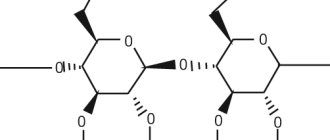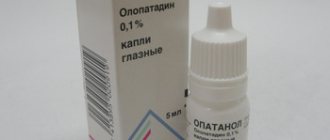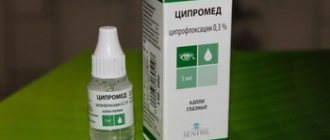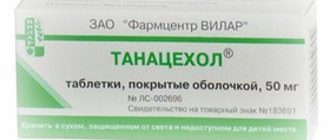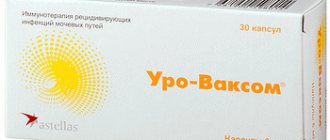Oftan Katahrom is a combined medication that is used in ophthalmology for the treatment and prevention of cataracts. The dosage form is eye drops. This drug contains active ingredients such as cytochrome C, adenosine and nicotinamide. The medicine has antioxidant, nourishing and anti-inflammatory properties. The drug cannot be used if there is an individual intolerance to the components. Pregnancy, lactation and childhood are relative contraindications.
Pharmacological authorities
Pharmacodynamics.
Action mechanism
Oftan® Katachrom for surgical cataracts is based mainly on the antioxidant and life-giving effect of its active components. It has been proven that Oftan® Katahrom can repair a friendly infusion on non-specific, non-infectious ignition processes of the anterior eye.
Cytochrome C is a lyso-porphyritic compound with a high molecular weight and a folding protein, the structure of which is similar to hemoglobin. It plays an important role in the biochemical oxidative processes of almost all aerobic organisms.
Pharmacodynamic effect
Cytochrome C in eye drops Oftan® Katachrom has the potential to neutralize oxygen radicals directly in the cornea, and is broken down into heme peptide in the internal ophthalmic region and epithelium of the eye crystal. Cytochrome C may also act as an antioxidant by inhibiting cytochrome oxidase in the crystalline epithelium of the eye, thereby preventing cataracts caused by radicals.
Adenosine plays multiple roles in eye drops. Vein promotes dilation of blood vessels and increased blood perfusion in the body. It vitalizes the eye crystal and cornea, and at the same time releases the flow of toxic catabolites, reducing the exchange of internal ocular fluid. Adenosine reduces inflammation of the conjunctiva, cornea and other anterior parts of the eye. This is a physiologically active endogenous molecule that inhibits inflammation, stimulating A2 receptors on the surface of the cell membrane. In addition, adenosine alters the suppression of inflammation mediators such as calcitonin gene-binding peptide.
Adenosine serves as a living substance and the main element in updated DNA and energy exchange/metabolism. Wine plays an indirect role in the daily processes of glutathione in the ocular crystal, since wine is a structural element of the enzyme glutathione reductase and NADP (nicotinamide adenine dinucleotide phosphate).
Nicotinamide is a structural element of the vitally important coenzymes NAD (nicotinamide adenine dinucleotide) and NADP (nicotinamide adenine dinucleotide phosphate). The addition of nicotinamide to the drug Oftan® Katachrom is based on the admixture, so that the development of cataracts can be eliminated/avoided by increasing the production of the epithelial cells of the eye crystal through additional metabolic living elements iv, necessary for the renewal of DNA and the activity of enzymes in the glutathione system.
Oftan® Katachrom is used to reduce the development of cataracts. Due to its low toxicity, it can also be used for preventive purposes. Treatment with the drug Oftan® Katachrom, as a rule, must be done in order to reach the underlying objective cortex of the dull, cloudy lens of the eye. In a placebo-controlled clinical study, the drug, after stagnation for 6-12 months, decreased cloudiness of the crystalline in cases of senile cataracts. Other studies and empirical clinical evidence have demonstrated effectiveness in as little as 6 months.
The action of the drug Oftan® Katachrom does not interfere with the crystalline of the eye; the drug is also anti-inflammatory, antioxidant, antibacterial, durable, disinfectant and ointment-infused on the surface of the eye. It has been proven that it is possible to perform a friendly infusion on non-specific, non-infectious ignition processes of the anterior eye.
Clinical effectiveness and safety
Follow-up of patients with keratoconjunctivitis confirms this point. 379 patients with flammable, traumatic and metabolic diseases of the cornea and conjunctiva, such as postherpetic keratopathy, corneal dystrophy, dry eye syndrome, chronic keratoconjunctivitis and chronic blepharo conjunctivitis, a very short term for swelling when treated with traditional steroid drugs in combined with ophthalmic drops Oftan® Katachrom, and also when treated with only steroid preparations.
Pharmacokinetics.
The active components of the eye drops Oftan® Katachrom are endogenous substances. Cytochrome C is composed of heme and one peptide lance (apocytochrome C), and adenosine is composed of purine (adenine) and sugar (D-ribose). The third active ingredient is nicotinamide.
Absorption
Cytochrome C itself does not penetrate into the cornea of great strength, but only penetrates after the cleavage of the peptide lance, and heme nonapeptide penetrates. Adenosine and nicotinamide penetrate the cornea easily and quickly.
Rozpodil
Absolute systemic bioavailability of cytochrome C after external intravenous administration is minimal. After penetration into the cornea, the heme is distributed almost to the skin tissue of the eye. Heme itself is lipophilic and when added hydrophobic, but with peptide or globin (hemoglobin) it becomes hydrophilic. After local ophthalmic stagnation, adenosine and nicotinamide are distributed in the dry tissues of the eye.
Biotransformation
Cytochrome C is extensively metabolized in the body. Apocytochrome C is degraded through amino acid metabolism, and heme is catabolized into bilirubin, which is excreted from the body in the liver. Adenosine is metabolized practically in all tissues of the body. Metabolites include inosine, xanthine and urate, which are excreted from the body through nitric acid. Ribose is metabolized through transketolase into glyceroaldehyde-3-phosphate and then into pyruvate and is residually oxidized into the Krebs cycle (citric acid cycle). Nicotinamide is frequently metabolized in the body by nicotinamide and nicotinic acid (niacin). These components are converted into N-methylnicotinamide, which is then decomposed in the liver.
Vividenya from the body
Heme cytochrome C is excreted from the body immediately, adenosine metabolites are excreted from the body immediately, as is the essential nicotinamide and its metabolites. The period of administration of adenosine from blood plasma becomes less than 1 hour, and that of nicotinic acid is even shorter, usually a few years.
pharmachologic effect
The benefits of the product for the eyes are ensured due to the complex effects of its main components. Adenosine, cytochrome and nicotinamide act as follows:
- Thanks to their powerful antioxidant properties, they have a neutralizing effect on oxidation processes that negatively affect the condition and functioning of the eyes.
- Restores the lens at the cellular level.
- Normalize and improve dissimilation and assimilation processes in the eyeball (inside it and on its membrane).
- They nourish and moisturize the membranes, which is especially important for patients who tend to have excessive dry eyes.
- They have a pronounced antiseptic effect, which reduces inflammation when foreign objects enter.
For myopia, they can improve vision slightly.
Interactions with other medicinal drugs and other types of interactions
No drug-drug interaction studies were performed.
It is not known whether there will be any significant interaction with other medications if the drugs are instilled locally into the eyes. Features of stagnation.
Drops of Ophtan® Catachrom are intended only for external condensation; they cannot be condensed for injection or oral administration.
Benzalkonium chloride
Drips of Oftan® Katahrom contain the preservative benzalkonium chloride.
Benzalkonium chloride can be adsorbed onto soft contact lenses and can change the color of contact lenses. It is necessary to remove contact lenses before stopping this drug and put them on again 15 minutes after stopping the drug.
Benzalkonium chloride may cause eye problems, especially if you have dry eyes or a damaged cornea (the clear sphere on the front of the eye). As soon as this medicinal procedure is used, the sensitiveness of the eyes, the heatiness or pain in the eyes is unavoidable, and it can be painful to see the doctor.
Dispose of any excess waste 4 days after first opening the bottle.
To avoid any clogged droplets and cracks, do not stick around the edge of the dropper on the surface of the excess plots or other plots.
Keep the bottle tightly closed if the drops are not victorious.
Drops are mixed with phosphate: sodium dihydrogen phosphate, dihydrate (4.415 mg/ml) and sodium hydrogen phosphate dihydrate (2.847 mg/ml).
With the first bottle:
When you open the bottle for the first time, screw on the cup, turning the cap behind the anniversary arrow, until the upper part of the bottle is tightly pressed, so that in the middle of the cup, opening the bottle opens.
The bottle is ready until the end, after unscrewing the cup, turning the cap against the anniversary arrow, it won’t come out.
There are no special considerations before disposal.
Be it a non-corrosive medicinal drug, or dispose of it in accordance with the local legislation.
Suspension during pregnancy or breastfeeding.
The infusion of ophthalmic drops of Oftan® Katachrom during pregnancy or breastfeeding was not monitored.
It is not recommended to use the drug during this period. This is due to the fluidity of the reaction during treatment with vehicles or other mechanisms.
Oftan® Katachrom does not cause any damage to the surface of the surface using transport or other mechanisms. As with the instillation of any ophthalmological preparations, if after instillation a short-term blurred vision occurs, the patient should check until a clear vision appears, before using transport means and treating with Other mechanisms.
special instructions
During treatment, you should not wear soft contact lenses, since the preservative contained in the drug may be deposited in them and have an adverse effect on the eye tissue. Before instillation, contact lenses must be removed and reinserted no earlier than after 15 minutes.
Impact on the ability to drive vehicles and complex mechanisms
Directly after instillation of Oftan Katahrom eye drops, short-term eye irritation is possible. Patients who experience this undesirable effect should refrain from any potentially hazardous activities immediately after instillation of the drug if visual acuity is required to perform them.
Method of congestion and dosage
Dosy:
bury 1-2 drops of mistsevo in the eye (eyes) 3 times per dose.
Method of curing:
ophthalmological stagnation.
In case of one-hour instillation of other ophthalmic drugs, it is necessary to maintain an interval of 5-15 weeks between instillations of the skin drug.
Children.
There is no conclusive data on the use of the drug Oftan® Katachrom in children.
Vkazivki on Wikoristan
1. Open the bottle. You cannot touch any objects with the tip of the bottle in order to remove any debris.
| 2. Move your head back, holding the bottle over your eye. |
Analogues of the product
If there are contraindications or side effects occur, it is recommended to stop using the medicine and use a substitute. The best analogue drugs:
- Taufon - has a wider scope. Used in the treatment of cataracts and for the correction of degenerative processes in the retina. The active ingredient is an amino acid containing sulfur. The mechanism of action is to stimulate metabolism in the soft tissues of the eye. Cost - from 95 to 120 rubles.
- Slezin is an ophthalmic solution with the active ingredients hypromellose and dextran. The medication has a positive effect on eye cells and energy processes. Price - from 190 to 230 rubles.
- Visomitin. The active ingredient is plastoquinonyldecyltriphenylphosphonium bromide. Restores damaged eye tissue. Average price - 473 rubles.
- Vidisik. The main indication for use is the presence of microcracks in the mucous membrane and tissues of the eye. The mechanism of action is to eliminate inflammation, swelling and irritation. The composition contains polyacrylic acid. Costs from 117 rubles.
- Vizimax. The action of the components of this product is aimed at improving metabolic processes and activating cell regeneration. The main purpose is the rapid recovery of the eyes after surgery, illness or injury. The price starts from 70 rubles.
Read more Instructions for using Suprastin drops
Other recommended analogues: Quinax (370 rubles), Catalin (524 rubles). The cost of Katachrom varies from 350 to 520 rubles.
Side effects
Nowadays, the significance comes down to the terminology of frequency, which is lower: even often (≥ 1/10); often (≥ 1/100 < 1/10); uncommon (≥ 1/1000 < 1/100); rare (≥ 1/10000 < 1/1000); very rare (< 1/10000) and the frequency is unknown (cannot be estimated from the available data).
Such undue infusions were reported during clinical investigations and post-marketing surveillance of Oftan® Katachrom eye drops. After small doses in case of ophthalmic stagnation, such side effects do not occur.
Between the skin groups of frequency, side effects are presented in the order of change in their severity.
Ophthalmic
Often: short-term pain in the eyes and teasing of the eyes.
Rarely: hypersensitivity reactions, including skin hissing, itching, hyperemia and skin swelling; allergic conjunctivitis, including pain in the eyes, hyperemia and itching of the eyes; contact dermatitis.
Non-ophthalmic
Very rarely: adenosine: boredom, confusion, arterial hypotension and shortness of breath.
Nicotinic acid: flushing, heat, restlessness and headache.
Invisible: lacrimation, short-term teasing of the eyes, associated with benzalkonium chloride (preservative).
Corneal lesions have been reported in some patients with severe corneal infections even rarely when using a binder instead of phosphate in eye drops.
Information about suspected unexpected reactions
Information about suspected adverse reactions following registration of a medicinal product is important. This allows for continuous (non-interruptive) monitoring of the relationship between the substance and the risk of the drug.
Doctors are asked to report any suspected unexpected reactions.
Contraindications and side effects
The use of drops is prohibited if there is an individual intolerance to the components of the medication, as well as for minors. A relative contraindication is the presence of glaucoma.
It is strictly forbidden to take the medicine orally or administer it intravenously or intramuscularly, as this can lead to a severe deterioration in the general condition (even death).
Harm from the use of drops in the form of side effects is possible only if they are used incorrectly and if there are contraindications. Possible side effects:
- Hypersensitivity reactions in the form of allergic manifestations on the skin: rash, itching, dermatitis, the appearance of conjunctivitis.
- Rarely: fainting, attacks of nausea, shortness of breath.
- General weakness, feeling of internal heat and hot flashes, decreased blood pressure.
Due to the individual characteristics of the body and intolerance to certain components, the following may occur:
- Feeling of burning and discomfort within 10 minutes after injection. This reaction is normal, is not dangerous and does not require discontinuation of the drug.
- Swelling of the upper and lower eyelids, extremely rarely - conjunctivitis.
- Feeling of pulsation in the crown or temples in the first 2-3 minutes. This is due to the fact that the drug has a dilating effect on the walls of blood vessels.
If side symptoms such as nausea, low blood pressure and eye inflammation appear, you need to stop the medicine and consult a doctor.
Read more Instructions for using Acerumen drops
Summary
Oftan Katahrom is a combination drug in the form of eye drops intended for the prevention and treatment of cataracts. Suitable for treatment of adult patients only. Advantages of the medicine:
- effectiveness and rapid manifestation of results (if prescribed in a timely manner);
- a small number of contraindications;
- complex action - not only stops the development of cataracts, but also prevents infection;
- low risk of developing serious side effects.
Minuses:
- relatively high cost;
- the impossibility of treating children and adolescents under 18 years of age with the drug;
- When instilled, a short-term burning sensation appears in the eyes.
Natalia Roy
Reviews about Oftan Katahrom
In general, reviews about Oftan Katahrom are positive. Many patients call this product an eye vitamin because it is most effective when used for preventive purposes, but also helps stop the development of cataracts. Eye drops nourish the eyes, dilate blood vessels, improve metabolic processes in the lens, relieve tension and improve vision.
Disadvantages include a short-term burning sensation immediately after instillation of the drug and a short shelf life of the drops after opening the bottle.
